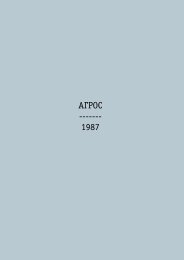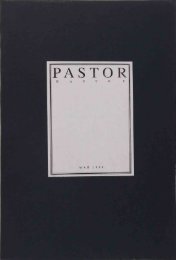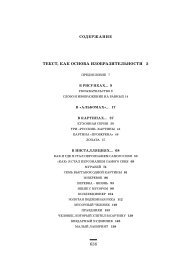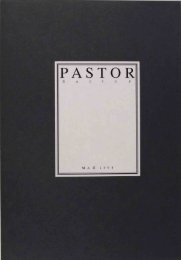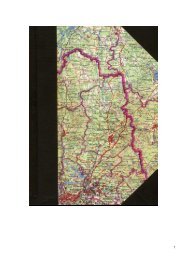А. Монастырский, Н. Панитков, И. Макаревич, Е. Елагина, С ...
А. Монастырский, Н. Панитков, И. Макаревич, Е. Елагина, С ...
А. Монастырский, Н. Панитков, И. Макаревич, Е. Елагина, С ...
You also want an ePaper? Increase the reach of your titles
YUMPU automatically turns print PDFs into web optimized ePapers that Google loves.
<strong>А</strong>. М.: В Лозунге-2005 актуальные контексты мне совершенно непонятны и<br />
неинтересны. Хотя, конечно, они там есть. Для меня этот Лозунг- абстрактная<br />
композиция, хроматическая структура прежде всего. Как музыкальное произведение.<br />
Там какие-то соотношения даосской и буддийской ментальностей (возможно, вполне<br />
актуальные- во всяком случае для КД). Очень странный, такой живой элемент- вязанка<br />
хвороста, которой был заменен магнитофон, и участие в пространстве акции<br />
фараоновой собаки.<br />
После предыдущих четырех акций на тему русского космизма эта последняя акция не<br />
вызывает во мне никаких дискурсивных желаний ее понимать. <strong>И</strong> это хорошо.<br />
S. Hänsgen, A. Monastyrski<br />
A DIALOGUE ON THE SLOGANS OF COLLECTIVE ACTIONS<br />
SH: The name of Collective Actions‘ (CA‘s) most recent piece Slogan 2005 contains a dual<br />
reference: on the one hand, it invokes a certain form of political design in Soviet culture, and on the<br />
other hand, it is associated with an entire tradition of CA performances involving slogans. To me, it<br />
would be interesting to use this action as a point of departure to explore the meaning of the specific<br />
relationship between exterior and interior contexts to the work of the group.<br />
An important narrative element of CA‘s performances in the genre Trips to the Countryside can be<br />
found in the crossing of a boundary, an aesthetic experience of liminality. At the same time, the<br />
transition from urban space into the rural landscape is connected to a process of semiotic reduction.<br />
The rural landscape – an empty field in the metaphysical sense – becomes the backdrop for minimal<br />
actions that thematize elementary spatio-temporal structures of perception: appearance –<br />
disappearance, approach – retreat, walking, standing, lying down, sound – silence, pause, and the<br />
rhythm of temporal extension. But as early as during the first foundational period of the group‘s<br />
activity, documented in the first volume of CA (1976-80), sign-material brought along from<br />
Moscow‘s metropolitan space was also used. In this sense, the actions with slogans seem especially<br />
salient and form an entire series in the earliest stage of the Collective Actions group.<br />
How would see the relationship between interior and exterior contexts in this earliest stage, using the<br />
actions with slogans as an example<br />
AM: The retreat from exterior Soviet contexts took place almost immediately after the first action,<br />
Slogan-77, which still made use of the Soviet slogan‘s form. The second action, Slogan-78, was<br />
already a reflection on the inner content of the first slogan, while the third slogan reflected the<br />
removal of the text from visual apprehension altogether, and its removal from discursivity to<br />
description, that is the complete formalization and ―nullification‖ of any ideological discourse<br />
whatsoever. The next action, Slogan-86, began in complete emptiness with the quality of a landscape<br />
(without any visible ―slogan-quality‖), returning a completely different discourse to this series,<br />
connected with only a priori contemplation, with space and time (its text is the foreword to the 4 th<br />
volume of Trips to the Countryside). On the level of plasticity, the formalism of Soviet ideology<br />
melts away into ―childish ideology‖, in the form of a ―children‘s secret‖, buried owls and dogs, made<br />
from a blackened map of the USSR.<br />
The next piece, Slogan-89 is a ready-made of (or pop-art on) the new ideology of monetarism that<br />
arose in Russia and bloomed in colorful opulence during the 1990s. Here, again, we can see a intense<br />
contact between interior and exterior contexts (the ―indiscernibility‖ of CA‘s aesthetics as a category<br />
and nascent monetarism, expressed by the financial billboard of the Slogan).<br />
Slogan-90 is a slogan that is difficult to grasp through discourse; it is somehow connected to an<br />
exterior chtonic world (the Moscow metro) and my own personal psychedelic adventures in the early<br />
1980s. It could be that the next piece, Slogan-96, has been ―raised up‖ out of this chtonic world,<br />
wrapped up with the figure of the professional Soviet philosopher Mikhail Ryklin, at the mercy of the<br />
new Russian discourse.




